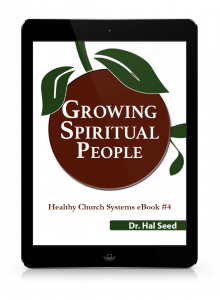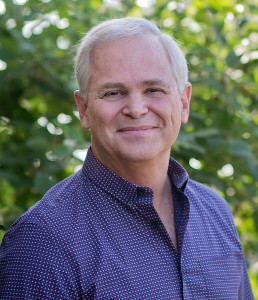
I always thought spiritual growth was like a buffet. You step up to the table and choose whatever looks good to you. You sample. You go back for seconds. And in the end, you’re done.
As a church leader using the cafeteria approach, I figured that if I could set out a variety of foods, then people could choose for themselves and under the direction of the Holy Spirit, they would mature in Christ naturally.
But that spiritual growth seemed to take forever.
I finally realized that we could help believers fire up their spiritual growth just by communicating more clearly about steps they could take to grow.
We worked through an eight step process to establish a spiritual growth system in our church. Perhaps this process will help you become more intentional about helping your congregation grow to spiritual maturity.
Spiritual Growth is a Collaboration
Spiritual growth is a three-way collaboration:
1. The believer is involved.
… continue to work out your salvation with fear and trembling… Philippians 2:12
2. God is involved.
… for it is God who works in you to will and to act in order to fulfill his good purpose. Philippians 2:13
3. Church leaders are involved.
My dear children, for whom I am again in the pains of childbirth until Christ is formed in you… Galatians 4:19
I have come to believe that my job is Paul’s job: to do my best to present everyone mature in Christ.
Developing a Spiritual Growth Path for your Church
The more steps a person takes, the more progress that person makes. So, our job, as spiritual leaders, is to create the steps and then put them in a logical order.
Chances are your church already has a whole bunch of tools, resources, events, classes, experiences and relationships that will help people grow. You may already be offering enough spiritual stimuli that all you need to do is chart a growth-path for your people to travel.
1. Develop a list of every spiritual growth opportunity you currently offer.
Make a list of everything your church does to help people grow in Christ.
I’m guessing you have:
- Weekend worship
- Serving opportunities
- Small Groups or Adult Sunday School
- Classes
- Baptisms
- Communion
- Prayer opportunities
- Short term missions trips
- Books you recommend
- And a half- dozen other things.
2. Put your opportunities in a logical order.
What’s the first thing you believe a brand new pagan-off-the-streets ought to do if they want to grow spiritually? Put that #1 on your list. What’s the second thing they ought to do? Make that #2.
Personally, I believe the first thing a brand new spiritual bystander should do is start coming to church. Because if they come they’ll develop some friendships, and that will cause them to stick as well as help them grow. And if they keep coming, they’ll inevitably become a Christian – which I believe ought to be step two.
So, #1: attend church regularly. #2: receive Christ.
What you’ll quickly discover is that you have many spiritual growth steps you’ve been taking for granted. This exercise will make you feel great about your church.
Once you’ve listed everything from attend church to lead someone else to Christ and disciple them into a mature believer, take your list and divide it into three phrases
3. Divide your growth steps into phases.
Nobody takes leaps; they only take steps. And it’s helpful if your steps are divided into phases, because that, too, seems more manageable.
I call our three phases: New Believer; Maturing Believer; Mature Believer. Or: 100 Level; 200 Level; 300 Level.
The key question when dividing spiritual progress into phases is: where does one phase end and a new phase begin?
Our 100 level focuses on new believers. We don’t expect them to feed themselves. “Just show up” we say, “and we’ll feed you.”
Our 200 level focuses on maturing believers. We tell them, “It’s time to assume responsibility for your own spiritual growth. Set your own alarm clock so you can get up in the morning. Put your own spoon in your mouth so you can get proper nutrients.”
Our 300 level focuses on what you might call “mature” believers, although none of us will ever truly be mature. We tell them, “You should be helping others grow in their relationship with Jesus.”
I think there should only be a few things in phase one, so that the new believer who follows your path is quickly encouraged that they are making progress.
4. Evaluate your phases to see if they are well-rounded.
Many of us believe that there are about five purposes for the church:
- Worship
- Fellowship
- Discipleship
- Service
- Evangelism
Is there something in each phase from this menu?
For instance, the first step you’ve asked of a new believer is to come to church. That’s worship.
Another step you’ve asked of them is to get into a one-on-one discipleship relationship. That could be both fellowship (at that stage) and discipleship.
I believe you should get new believers serving right away. So maybe you ought to add “serve somewhere in the church one time” to your 100 level.
And then, an evangelism step in the first phase probably should be “invite a friend to church.”
5. Get leadership buy in.
Loop in your staff and leadership board during the development phase to give them opportunity for input and buy in. Be sure they understand the Biblical basis and the practical benefits of a spiritual growth process.
6. Get a graphic artist to design a professional-looking brochure.
Once you’ve sketched out your process, get a graphic artist to put a little checkbox in front of each of the items and design a brochure for them.
Congratulations, you just developed a spiritual growth path and process for your church!
Now it’s time to spread the word.
7. Preach a series on spiritual progress.
Preach a series on spiritual progress to launch your spiritual growth path. Challenge your congregation to take responsibility for their spiritual growth and teach them how they can be more intentional.
And preach a series about it annually. At New Song, we teach people about Next Steps twice a year.
When we preach about Next Steps, we include our brochure in the bulletin. During the application time we say, “Take your Next Steps Brochure out of your bulletin right now and open it up. You’ll notice that there is a little box next to each event and activity on the page. Check off all the things you’re doing or have already done. When you come to a box you can’t check off, that’s your Next Step.”
During the sermon we remind everyone that keys to spiritual growth are:
- Begin immediately.
- Spiritual growth is not automatic, and spiritual atrophy is inevitable. You are either growing forward or declining in spiritual maturity.
- The more steps you take, the more progress you make.
There are just a few more things to do to keep the system pretty much running on its own inertia.
8. Embed it in your church ministries.
- Mention it during the services every weekend.
We invite people to the front to meet with a Next Steps Counselor during every service. During our offering time each week, we have prayer partners available at the front of the auditorium. We ask people to come for prayer “big or small, anything at all,” and we say, “And if you’d like to know what your next step in faith is, our Next Steps Counselor is standing in the corner over there and would love to help you determine your next step with Jesus.”
- Teach your spiritual process in your new member’s class.
- Ask your ministries to apply and support it in their contexts. What does it look like for children and teens? How are your small groups, and men’s and women’s ministries, intentionally facilitating spiritual growth?
Set aside a chunk of time to do some thinking – or set up a meeting with a couple of good thinkers – to hash out what you have at your church that helps people grow spiritually, and how it fits into a process.
Then put it on the agendas for your next staff and board meetings.
Now What?
If you’d like more help to fire up spiritual growth in your church, I like you to have free access to my ChurchEngines lesson on developing your Discipleship System.
Get Free Access to Discipleship System Video Lesson
 Or you may want to get my ebook: Growing Spiritual People.
Or you may want to get my ebook: Growing Spiritual People.
Like Paul, let’s do our best to present everyone mature in Christ!
 Hal Seed is the founding and Lead Pastor of New Song Community Church in Oceanside, CA. He mentors pastors who want to lead healthy, growing churches with resources at www.pastormentor.com.
Hal Seed is the founding and Lead Pastor of New Song Community Church in Oceanside, CA. He mentors pastors who want to lead healthy, growing churches with resources at www.pastormentor.com.
Start Here to learn more about the resources available for you at PastorMentor.

What about when applying to different country situations which is different from a country like america
Great information. Will definitely take it to my small church and try to implement some of it.
Thank you for sharing.
Good for you Jacqueline! Smaller items can catch fire and burn quicker than bigger ones!
Good question Victor!
The principles we are trying to communicate are (1) The process of spiritual growth is a process. The steps forward don’t have to follow in an exact order, but some steps should be taken early (like receiving Christ, getting baptized, started to attend church), others should be taken soon thereafter (like learning to pray and read a Bible – if one is available in your country and language). Some spiritual steps and habits build on others (leading a small group should happen after you’ve experienced being a member of a small group). (2) The second principle is that, as a church leader, you’ll want to help your members take each of those steps, and if possible, help direct them to appropriate next steps as they grow. So, putting your spiritual disciples or, as we call them, “Next Steps” in a suggested order makes sense, and should apply in some way to every culture and country.
Thanks for the information